Highly Efficient Degradation of 2-Methylisoborneol by Laccase Assisted by a Micro-Electric Field
Abstract
1. Introduction
2. Results and Discussion
2.1. Effects of Reaction Parameters on Degradation of 2-MIB Catalyzed by Laccase
2.1.1. Effect of pH on Catalytic Degradation of 2-MIB by Laccase
2.1.2. Effect of Temperature on Catalytic Degradation of 2-MIB by Laccase
2.1.3. Effect of Stirring Speed on Catalytic Degradation of 2-MIB by Laccase
2.1.4. Effect of Enzyme Dosage on Catalytic Degradation of 2-MIB by Laccase
2.1.5. Effect of Initial 2-MIB Concentration on Its Degradation Catalyzed by Laccase
2.1.6. Effect of Electric Field Intensity on 2-MIB Degradation Catalyzed by Laccase
2.2. Analysis for the Intermediates of 2-MIB Degradation
2.2.1. Possible Degradation Pathway of 2-MIB Catalyzed by Laccase
2.2.2. Possible Degradation Pathways of 2-MIB by Electrocatalysis
2.2.3. Possible Degradation Pathways of 2-MIB Catalyzed by Laccase Assisted by a Micro-Electric Field
3. Materials and Methods
3.1. Chemicals
3.2. Experimental Procedure for 2-MIB Degradation
3.2.1. Preparation of Laccase Stock Solution
3.2.2. Degradation of 2-MIB Catalyzed by Laccase
3.2.3. Degradation of 2-MIB Catalyzed by Micro-Electric Field
3.3. Analysis
3.3.1. Determination of Laccase Activity
3.3.2. Analysis of 2-MIB and Its Intermediate Degradation Products
3.3.3. Calculation of 2-MIB Degradation Rate
4. Conclusions
Supplementary Materials
Author Contributions
Funding
Data Availability Statement
Acknowledgments
Conflicts of Interest
References
- Li, L.; Yang, S.; Yu, S.; Zhang, Y. Variation and removal of 2-MIB in full-scale treatment plants with source water from Lake Tai, China. Water Res. 2019, 162, 180–189. [Google Scholar] [CrossRef] [PubMed]
- Yu, C.; Shi, C.; Tang, J.; Ji, Q.; Wang, X.; Xu, X.; Wang, G. Release of taste and odour compounds during Zizania latifolia decay: A microcosm system study. Environ. Pollut. 2019, 254, 112954. [Google Scholar] [CrossRef]
- Wang, F.; Li, X.; Liu, T.; Li, X.; Cui, Y.; Xu, L.; Huo, S.; Zou, B.; Qian, J.; Ma, A.; et al. Removal of Taste and Odor Compounds from Water: Methods, Mechanism and Prospects. Catalysts 2023, 13, 1356. [Google Scholar] [CrossRef]
- Zahraei, S.K.; Salemi, A.; Schmidt, T.C. Sample preparation for determination of water taste and odor compounds: A review. Trends Environ. Anal. Chem. 2021, 32, e00149. [Google Scholar] [CrossRef]
- Kim, T.-K.; Moon, B.-R.; Kim, T.; Kim, M.-K.; Zoh, K.-D. Degradation mechanisms of geosmin and 2-MIB during UV photolysis and UV/chlorine reactions. Chemosphere 2016, 162, 157–164. [Google Scholar] [CrossRef]
- Soyluoglu, M.; Kim, D.; Zaker, Y.; Karanfil, T. Removal mechanisms of geosmin and MIB by oxygen nanobubbles during water treatment. Chem. Eng. J. 2022, 443, 136535. [Google Scholar] [CrossRef]
- Abu Hasan, H.; Muhammad, M.H.; Ismail, N.I. A review of biological drinking water treatment technologies for contaminants removal from polluted water resources. J. Water Process Eng. 2020, 33, 101035. [Google Scholar] [CrossRef]
- Mustapha, S.; Tijani, J.O.; Ndamitso, M.M.; Abdulkareem, A.S.; Shuaib, D.T.; Mohammed, A.K. A critical review on geosmin and 2-methylisoborneol in water: Sources, effects, detection, and removal techniques. Environ. Monit. Assess. 2021, 193, 204. [Google Scholar] [CrossRef]
- Barbusinski, K.; Kalemba, K.; Kasperczyk, D.; Urbaniec, K.; Kozik, V. Biological methods for odor treatment—A review. J. Clean. Prod. 2017, 152, 223–241. [Google Scholar] [CrossRef]
- Cococeanu, A.L.; Man, T.E. Methods and Characteristics of Conventional Water Treatment Technologies. In Water Safety, Security and Sustainability: Threat Detection and Mitigation; Springer: Cham, Switzerland, 2021; pp. 305–330. [Google Scholar]
- Zheng, Z.-X.; Lin, Y.-L.; Fang, R.-F.; Zhou, X.-Y.; Liu, Z.; Dong, Z.-Y.; Zhang, T.-Y.; Xu, B. Removal of algae and algogenic odor compounds via combined pre-chlorination and powdered activated carbon adsorption for source water pretreatment. Sep. Purif. Technol. 2023, 304, 122365. [Google Scholar] [CrossRef]
- Piezer, K.; Li, L.; Jeon, Y.; Kadudula, A.; Seo, Y. The Application of Potassium Permanganate to Treat Cyanobacteria-Laden Water: A Review. Process Saf. Environ. Prot. 2021, 148, 400–414. [Google Scholar] [CrossRef]
- Du, K.; Zhou, B.; Yuan, R. Biodegradation of 2-methylisoborneol by single bacterium in culture media and river water environment. Int. J. Environ. Stud. 2017, 74, 399–411. [Google Scholar] [CrossRef]
- Drummond, L.; von Wallbrunn, C.; Buchhaupt, M. Microbial Degradation of 2-Methylisoborneol in Forest Soil**. Chem. Biodivers. 2022, 19, e202100734. [Google Scholar] [CrossRef]
- Du, H.; Wang, Z.; Sun, Y.; Shah, K.J. An Overview of the Progress made in Research on Odor Removal in Water Treatment Plants. Water 2024, 16, 280. [Google Scholar] [CrossRef]
- Shao, X.; Du, K. Biodegradation of 2-methylisoborneol by enzyme separated from Pseudomonas mandelii. Water Supply 2020, 20, 2096–2105. [Google Scholar] [CrossRef]
- Chmelova, D.; Ondrejovic, M.; Miertus, S. Laccases as Effective Tools in the Removal of Pharmaceutical Products from Aquatic Systems. Life 2024, 14, 230. [Google Scholar] [CrossRef]
- Dong, C.-D.; Tiwari, A.; Anisha, G.S.; Chen, C.-W.; Singh, A.; Haldar, D.; Patel, A.K.; Singhania, R.R. Laccase: A potential biocatalyst for pollutant degradation*. Environ. Pollut. 2023, 319, 120999. [Google Scholar] [CrossRef]
- Bilal, M.; Rasheed, T.; Nabeel, F.; Iqbal, H.M.N.; Zhao, Y. Hazardous contaminants in the environment and their laccase-assisted degradation—A review. J. Environ. Manag. 2019, 234, 253–264. [Google Scholar] [CrossRef]
- Jia, J.; Xue, P.; Ma, L.; Li, P.; Xu, C. Deep degradation of atrazine in water using co-immobilized laccase-1-hydroxybenzotriazole-Pd as composite biocatalyst. J. Hazard. Mater. 2024, 468, 133779. [Google Scholar] [CrossRef]
- Min, Y.; Mei, S.-C.; Pan, X.-Q.; Chen, J.-J.; Yu, H.-Q.; Xiong, Y. Mimicking reductive dehalogenases for efficient electrocatalytic water dechlorination. Nat. Commun. 2023, 14, 5134. [Google Scholar] [CrossRef]
- AlJaberi, F.Y.; Ahmed, S.A.; Makki, H.F.; Naje, A.S.; Zwain, H.M.; Salman, A.D.; Juzsakova, T.; Viktor, S.; Van, B.; Le, P.-C.; et al. Recent advances and applicable flexibility potential of electrochemical processes for wastewater treatment. Sci. Total Environ. 2023, 867, 161361. [Google Scholar] [CrossRef] [PubMed]
- Wei, K.; Shen, C.; Han, W.; Li, J.; Sun, X.; Shen, J.; Wang, L. Advance treatment of chemical industrial tailwater by integrated electrochemical technologies: Electrocatalysis, electrodialysis and electro-microfiltration. Chem. Eng. J. 2017, 310, 13–21. [Google Scholar] [CrossRef]
- Panizza, M.; Cerisola, G. Direct And Mediated Anodic Oxidation of Organic Pollutants. Chem. Rev. 2009, 109, 6541–6569. [Google Scholar] [CrossRef] [PubMed]
- Zhao, C.; Yang, X.; Zhao, B.; Zhang, Z.; Guo, W.; Shen, A.; Ye, M.; Wang, W. Copper porphyrin MOF/graphene oxide composite membrane with high efficiency electrocatalysis and structural stability for wastewater treatment. J. Membr. Sci. 2024, 695, 122499. [Google Scholar] [CrossRef]
- Wang, F.; Owusu-Fordjour, M.; Xu, L.; Ding, Z.; Gu, Z. Immobilization of Laccase on Magnetic Chelator Nanoparticles for Apple Juice Clarification in Magnetically Stabilized Fluidized Bed. Front. Bioeng. Biotechnol. 2020, 8, 589. [Google Scholar] [CrossRef]
- Cao, X.; Gao, J.; Yang, Y.; Li, H.; Zheng, X.; Liu, G.; Jiang, Y. Synergistic degradation of chlorophenol pollutants by a photo-enzyme integrated catalyst. J. Environ. Chem. Eng. 2022, 10, 107909. [Google Scholar] [CrossRef]
- Pang, S.; Wu, Y.; Zhang, X.; Li, B.; Ouyang, J.; Ding, M. Immobilization of laccase via adsorption onto bimodal mesoporous Zr-MOF. Process Biochem. 2016, 51, 229–239. [Google Scholar] [CrossRef]
- Saoudi, O.; Ghaouar, N. Biocatalytic characterization of free and immobilized laccase from Trametes versicolor in its activation zone. Int. J. Biol. Macromol. 2019, 128, 681–691. [Google Scholar] [CrossRef]
- Dai, Y.; Yao, J.; Song, Y.; Liu, X.; Wang, S.; Yuan, Y. Enhanced performance of immobilized laccase in electrospun fibrous membranes by carbon nanotubes modification and its application for bisphenol A removal from water. J. Hazard. Mater. 2016, 317, 485–493. [Google Scholar] [CrossRef]
- Zhou, W.; Zhang, W.; Cai, Y. Laccase immobilization for water purification: A comprehensive review. Chem. Eng. J. 2021, 403, 126272. [Google Scholar] [CrossRef]
- Deng, J.; Wang, H.; Zhan, H.; Wu, C.; Huang, Y.; Yang, B.; Mosa, A.; Ling, W. Catalyzed degradation of polycyclic aromatic hydrocarbons by recoverable magnetic chitosan immobilized laccase from Trametes versicolor. Chemosphere 2022, 301, 134753. [Google Scholar] [CrossRef] [PubMed]
- Schwienheer, C.; Prinz, A.; Zeiner, T.; Merz, J. Separation of active laccases from Pleurotus sapidus culture supernatant using aqueous two-phase systems in centrifugal partition chromatography. J. Chromatogr. B-Anal. Technol. Biomed. Life Sci. 2015, 1002, 1–7. [Google Scholar] [CrossRef] [PubMed]
- Wojtusik, M.; Zurita, M.; Villar, J.C.; Ladero, M.; Garcia-Ochoa, F. Influence of fluid dynamic conditions on enzymatic hydrolysis of lignocellulosic biomass: Effect of mass transfer rate. Bioresour. Technol. 2016, 216, 28–35. [Google Scholar] [CrossRef] [PubMed]
- Sutar, R.S.; Rathod, V.K. Ultrasound assisted Laccase catalyzed degradation of Ciprofloxacin hydrochloride. J. Ind. Eng. Chem. 2015, 31, 276–282. [Google Scholar] [CrossRef]
- Du, J.; Cao, Y.; Liu, G.; Zhao, J.; Li, X.; Qu, Y. Identifying and overcoming the effect of mass transfer limitation on decreased yield in enzymatic hydrolysis of lignocellulose at high solid concentrations. Bioresour. Technol. 2017, 229, 88–95. [Google Scholar] [CrossRef] [PubMed]
- Escalona, I.; de Grooth, J.; Font, J.; Nijmeijer, K. Removal of BPA by enzyme polymerization using NF membranes. J. Membr. Sci. 2014, 468, 192–201. [Google Scholar] [CrossRef]
- Yusof, N. Production of Chitosan Oligosaccharides using β-glycosidic degrading enzyme: Optimization using Response Surface Methodology. Malays. J. Appl. Sci. 2020, 31, 30–44. [Google Scholar] [CrossRef]
- Xue, Q.; Shimizu, K.; Sakharkar, M.K.; Utsumi, M.; Cao, G.; Li, M.; Zhang, Z.; Sugiura, N. Geosmin degradation by seasonal biofilm from a biological treatment facility. Environ. Sci. Pollut. Res. 2012, 19, 700–707. [Google Scholar] [CrossRef]
- Abd El-Hack, M.E.; El-Saadony, M.T.; Elbestawy, A.R.; Ellakany, H.F.; Abaza, S.S.; Geneedy, A.M.; Salem, H.M.; Taha, A.E.; Swelum, A.A.; Omer, F.A.; et al. Undesirable odour substances (geosmin and 2-methylisoborneol) in water environment: Sources, impacts and removal strategies. Mar. Pollut. Bull. 2022, 178, 113579. [Google Scholar] [CrossRef]
- Zhang, K.; Yang, W.; Liu, Y.; Zhang, K.; Chen, Y.; Yin, X. Laccase immobilized on chitosan-coated Fe3O4 nanoparticles as reusable biocatalyst for degradation of chlorophenol. J. Mol. Struct. 2020, 1220, 128769. [Google Scholar] [CrossRef]
- Camarero, S.; Ibarra, D.; Martínez, M.J.; Martínez, A.T. Lignin-derived compounds as efficient laccase mediators for decolorization of different types of recalcitrant dyes. Appl. Environ. Microbiol. 2005, 71, 1775–1784. [Google Scholar] [CrossRef] [PubMed]
- Jones, S.M.; Solomon, E.I. Electron transfer and reaction mechanism of laccases. Cell. Mol. Life Sci. 2015, 72, 869–883. [Google Scholar] [CrossRef] [PubMed]
- Wang, C.; Zhang, H.; Ren, D.; Li, Q.; Zhang, S.; Feng, T. Effect of Direct-Current Electric Field on Enzymatic Activity and the Concentration of Laccase. Indian J. Microbiol. 2015, 55, 278–284. [Google Scholar] [CrossRef] [PubMed]
- Zhang, Y.; Jiang, W.; Dong, H.; Hu, X.; Fang, B.; Gao, G.; Zhao, R. Study on the Electrochemical Removal Mechanism of Oxytetracycline by a Ti/IrO2-Ta2O5 Plate. Int. J. Environ. Res. Public Health 2021, 18, 1708. [Google Scholar] [CrossRef] [PubMed]
- Shi, S.; Xu, J.; Zeng, Q.; Liu, J.; Hou, Y.; Jiang, B. Impacts of applied voltage on EMBR treating phenol wastewater: Performance and membrane antifouling mechanism. Bioresour. Technol. 2019, 282, 56–62. [Google Scholar] [CrossRef] [PubMed]
- Yuan, Y.; Guo, S.-H.; Li, F.-M.; Li, T.-T. Effect of an electric field on n-hexadecane microbial degradation in contaminated soil. Int. Biodeterior. Biodegrad. 2013, 77, 78–84. [Google Scholar] [CrossRef]
- Li, T.; Guo, S.; Wu, B.; Li, F.; Niu, Z. Effect of electric intensity on the microbial degradation of petroleum pollutants in soil. J. Environ. Sci. 2010, 22, 1381–1386. [Google Scholar] [CrossRef]
- Li, F.; Guo, S.; Wu, B.; Wang, S. Pilot-scale electro-bioremediation of heavily PAH-contaminated soil from an abandoned coking plant site. Chemosphere 2020, 244, 125467. [Google Scholar] [CrossRef]
- Bu, L.; Zhou, S.; Shi, Z.; Deng, L.; Gao, N. Removal of 2-MIB and geosmin by electrogenerated persulfate: Performance, mechanism and pathways. Chemosphere 2017, 168, 1309–1316. [Google Scholar] [CrossRef]
- Wu, H.; Liu, J.; Zhou, X.; Liu, F.; Bai, X.; Wang, R.; Xu, H.; Tan, L.; Zhang, J. Degradation of Bisphenols by Micro-Nano Bubbles Assisted Laccase: Kinetics, Michaelis-Menten Kinetics, Degradation Pathway, and Transformation Relationship. Catal. Lett. 2024, 1–14. [Google Scholar] [CrossRef]
- Raj, R.; Tripathi, A.; Das, S.; Ghangrekar, M.M. Removal of caffeine from wastewater using electrochemical advanced oxidation process: A mini review. Case Stud. Chem. Environ. Eng. 2021, 4, 100129. [Google Scholar] [CrossRef]
- Comninellis, C. Electrocatalysis in the electrochemical conversion/combustion of organic pollutants for waste water treatment. Electrochim. Acta 1994, 39, 1857–1862. [Google Scholar] [CrossRef]
- Huo, S.H.; Liu, J.Z.; Zhu, F.F.; Basheer, S.; Necas, D.; Zhang, R.C.; Li, K.; Chen, D.J.; Cheng, P.F.; Cobb, K.; et al. Post treatment of swine anaerobic effluent by weak electric field following intermittent vacuum assisted adjustment of N:P ratio for oil-rich filamentous microalgae production. Bioresour. Technol. 2020, 314, 123718. [Google Scholar] [CrossRef] [PubMed]
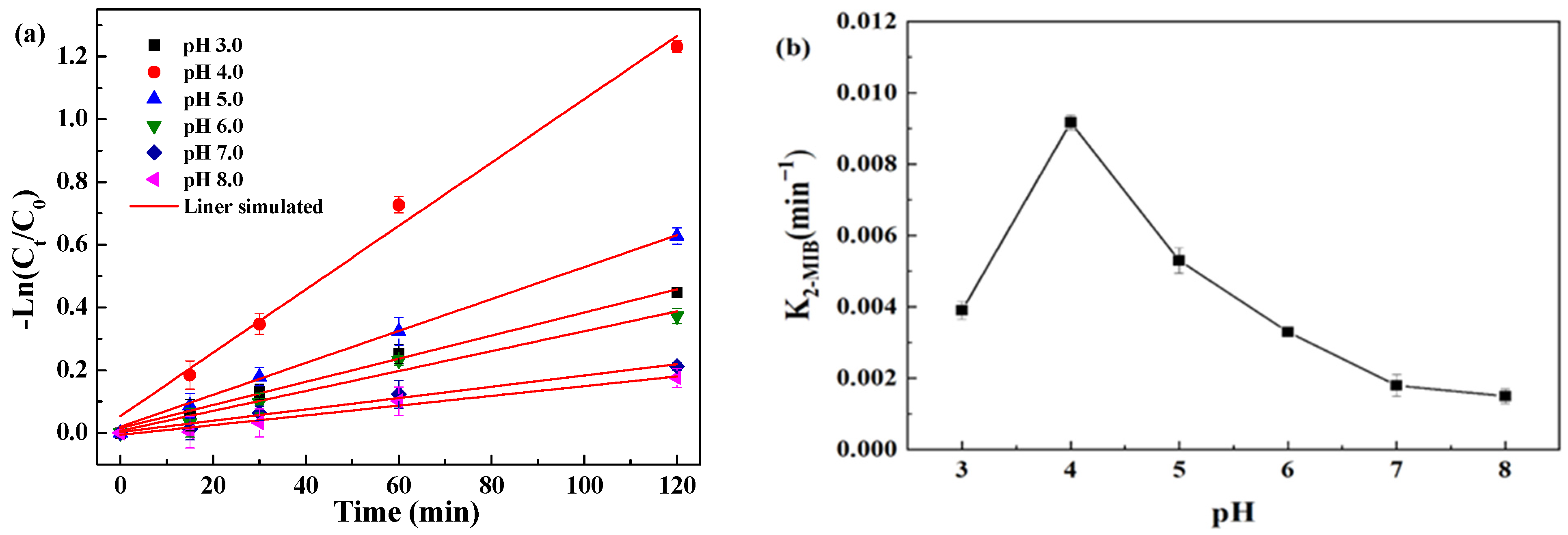
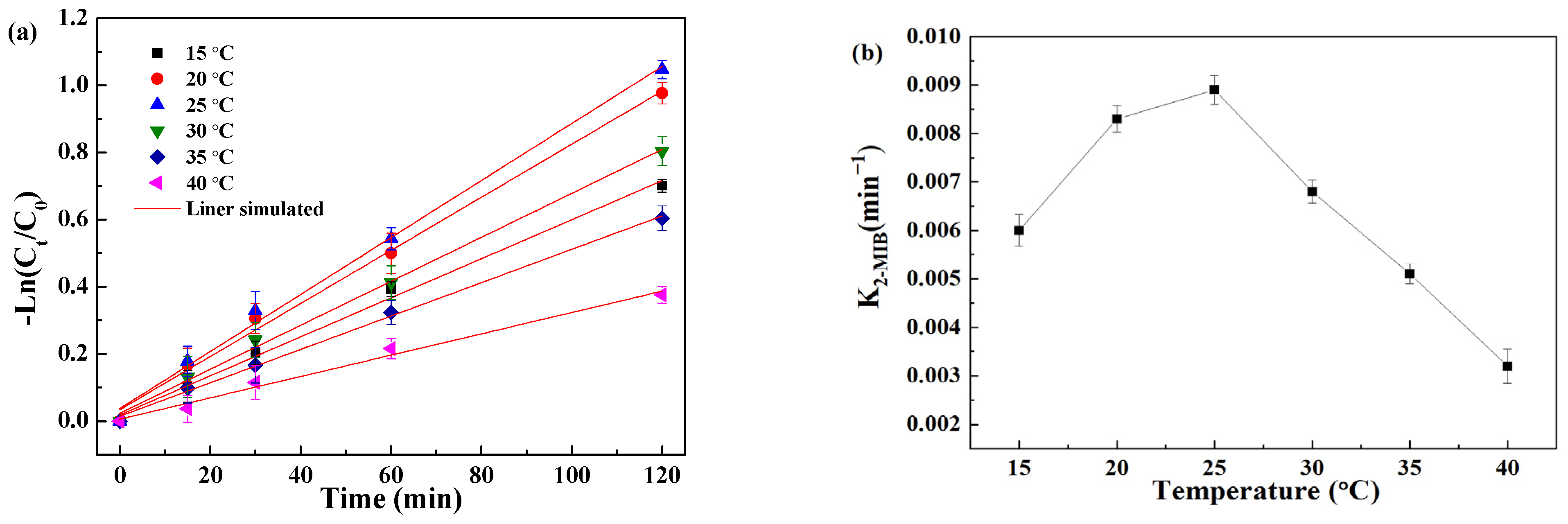



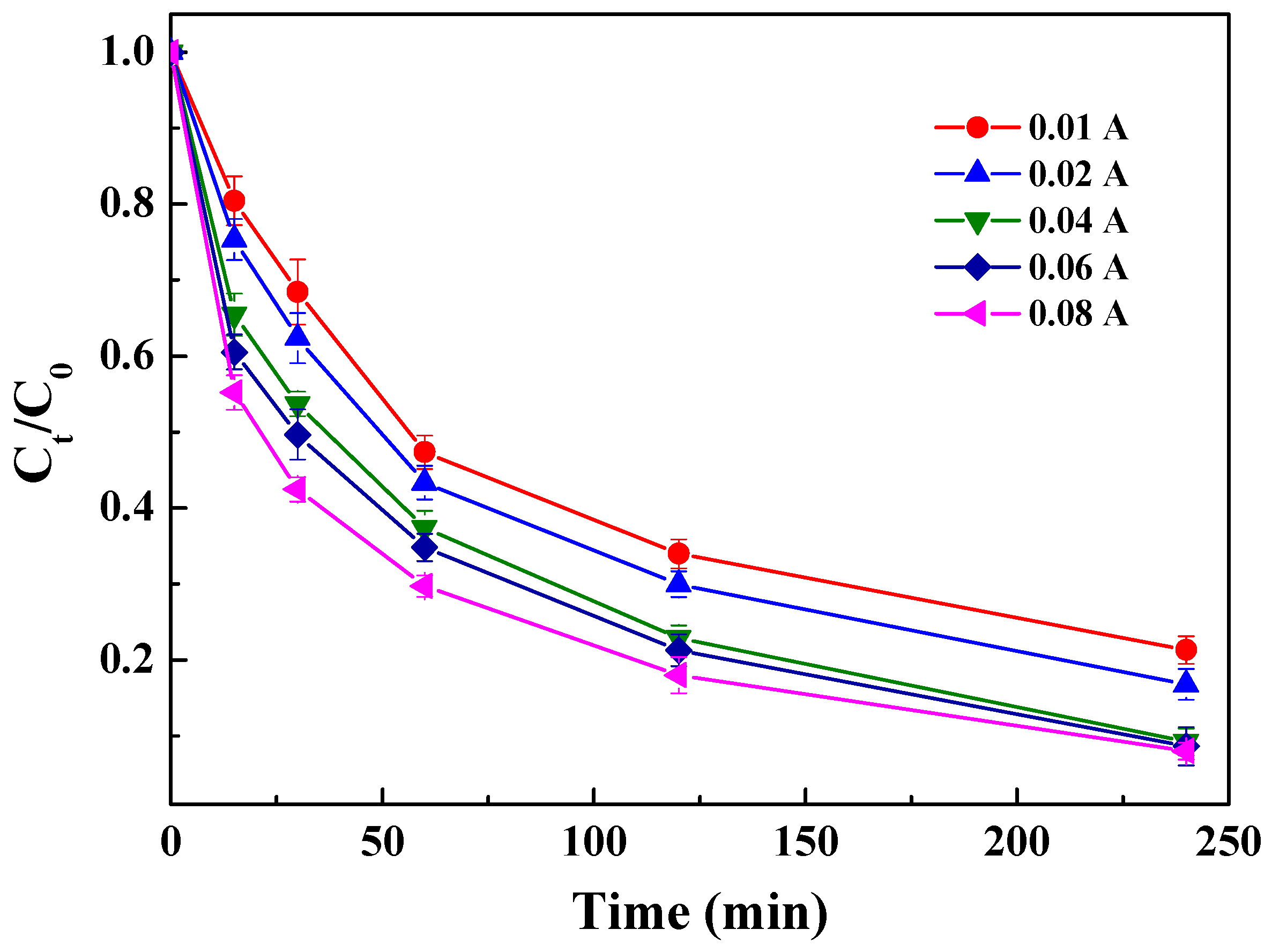


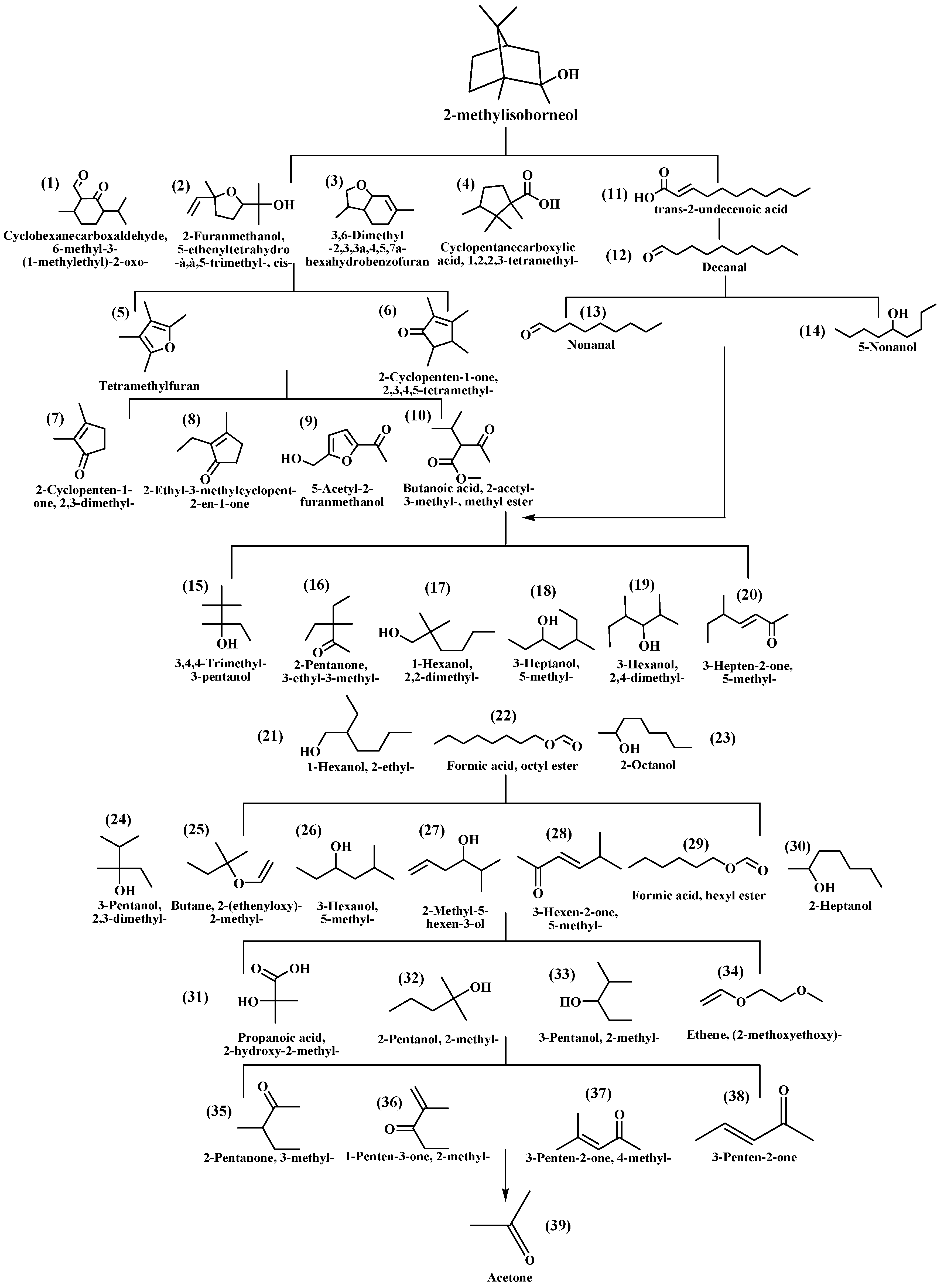
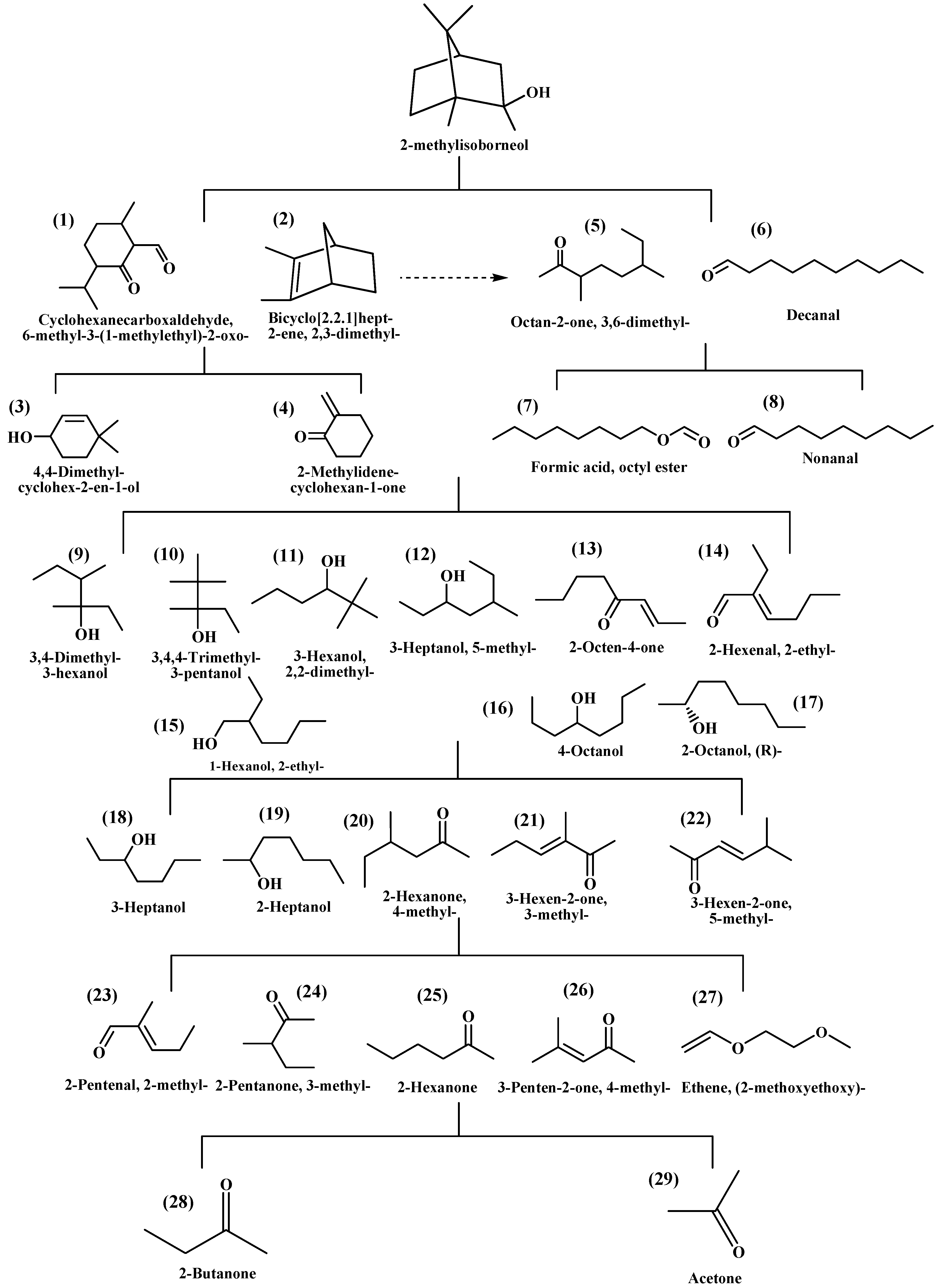
Disclaimer/Publisher’s Note: The statements, opinions and data contained in all publications are solely those of the individual author(s) and contributor(s) and not of MDPI and/or the editor(s). MDPI and/or the editor(s) disclaim responsibility for any injury to people or property resulting from any ideas, methods, instructions or products referred to in the content. |
© 2024 by the authors. Licensee MDPI, Basel, Switzerland. This article is an open access article distributed under the terms and conditions of the Creative Commons Attribution (CC BY) license (https://creativecommons.org/licenses/by/4.0/).
Share and Cite
Xu, L.; Li, B.; Liu, T.; Ma, A.; Zhuang, G.; Qian, J.; Cui, Y.; Huo, S.; Xia, J.; Wang, F. Highly Efficient Degradation of 2-Methylisoborneol by Laccase Assisted by a Micro-Electric Field. Catalysts 2024, 14, 649. https://doi.org/10.3390/catal14090649
Xu L, Li B, Liu T, Ma A, Zhuang G, Qian J, Cui Y, Huo S, Xia J, Wang F. Highly Efficient Degradation of 2-Methylisoborneol by Laccase Assisted by a Micro-Electric Field. Catalysts. 2024; 14(9):649. https://doi.org/10.3390/catal14090649
Chicago/Turabian StyleXu, Ling, Beidian Li, Tingting Liu, Anzhou Ma, Guoqiang Zhuang, Jingya Qian, Yi Cui, Shuhao Huo, Jiexiang Xia, and Feng Wang. 2024. "Highly Efficient Degradation of 2-Methylisoborneol by Laccase Assisted by a Micro-Electric Field" Catalysts 14, no. 9: 649. https://doi.org/10.3390/catal14090649
APA StyleXu, L., Li, B., Liu, T., Ma, A., Zhuang, G., Qian, J., Cui, Y., Huo, S., Xia, J., & Wang, F. (2024). Highly Efficient Degradation of 2-Methylisoborneol by Laccase Assisted by a Micro-Electric Field. Catalysts, 14(9), 649. https://doi.org/10.3390/catal14090649






